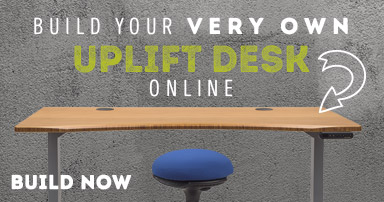Quick and Easy Office Ergonomic Tips
Posted by Human Solution on May 8th 2013
Setting up an ergonomic workstation may seem complex and overwhelming. Unless you're an ergonomist, it can be hard to know which products are best for your needs, and how to put them all together for workplace health. Luckily, our friends at the ergonomic consulting firm Humantech have provided a simple way to assess your ergonomic requirements and help you determine how to meet them. They call it the four points of contact.
1. Eyes to source. This means that your monitor should be at least an arm's length away from your eyes, and it should be positioned so that the top of the display is at or just below eye level. You might need this a bit lower if you wear bifocals or transition lenses. If glare is a problem, tilt the monitor forward slightly.
2. Hands to input device. The keyboard should be positioned so that your upper arms hang comfortably from your shoulders and your forearms are horizontal. Elbows should be at about 90°. Depending on your current work setup, this can be achieved by using a keyboard tray. A keyboard tray should be height adjustable, provide space for a mouse, have a thigh clearance of at least 7", and allow the user to lock the tray into position. Whether you use a keyboard tray or not, make sure you are close enough to your workstation to avoid reaching. Keep your mouse next to and at the same level as your keyboard. Don't let your wrists or palms rest on anything as you type or mouse. Your hands should "float" instead.
3. Body to chair. Knees should be at about a 90° angle. Allow two fingers to a closed fist size of space between the back of your knees and the seat edge. Adjust the seat back so that the lumbar support fits into your lumbar curve, and ensure your entire back is supported by the chair. In choosing a chair, make sure it has the following features: pneumatic height adjustment, lumbar support, adjustable back recline, height and width adjustable armrests, a rounded or waterfall seat edge, and a five-leg base on casters.
4. Feet to floor. Feet should be flat on the floor or on a footrest. Do not sit on your legs or prop them on chair legs.
Those are a few basics to get you started. It's also important to remember that just because you have a good ergonomic set-up, you shouldn't stay put all day. Get up regularly to take breaks from sitting, or consider a sit-stand workstation for more flexibility. To take care of your eyes, follow the 20-20-20 rule: Every 20 minutes, look 20 feet away for 20 seconds. You should also change work activities in order to give yourself a break from repetitive tasks, like making a few phone calls to take a break from typing. Finally, be sure to take stretch breaks to give your weary muscles some TLC. Your doctor can recommend some stretches that are suited to your particular musculoskeletal issues.
Give us a call at 800-531-3746 if you need recommendations on staying healthy at work. We love talking about this stuff!
Learn more about ergonomic office products at TheHumanSolution.com




